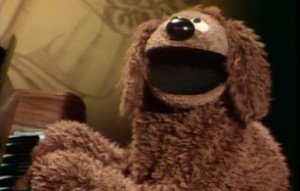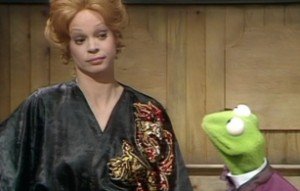The Muppet Show 1.01: “Juliet Prowse”
It’s been over a year in the making, but now I can finally type the words I’ve been waiting to write for what seems like forever: we’ve finally reached the very first episode of The Muppet Show!! And what a journey it has been, both for Jim Henson and us, with so many pilots, dreams, hopes, false starts, and near misses finally culminating in the series that Jim spent practically his entire career working to bring to fruition. A show that, just as he predicted in his pitch reel, did become the most popular in the world!
Now, I’ve seen The Muppet Show, particularly the first three seasons, since they’re the only ones currently available on DVD, numerous times, but what might be most fascinating to me on this viewing is that, whereas before, I had immediately noticed what felt off about the first season of the show, during which it was still very much a work in progress that hadn’t yet become the classic it is remembered as today, this time around, having spent over a year chronologically experiencing all of the earlier Muppet material before getting to it, I was struck by how much this first episode felt like finally reaching home. Yes, there are major differences: the theme song sequence isn’t the one we know and love; Frank Oz hasn’t gotten Fozzie’s voice down right yet; Gonzo is a sad sack performance artist rather than a wide-eyed daredevil; the later-ubiquitous Pigs in Space doesn’t exist yet; and perhaps most shockingly, Miss Piggy is considered so inessential a character that her vocal performance duties are split–in some sketches, her voice is performed by Frank Oz and, in others, Richard Hunt! But, in so many respects, it feels so much righter than any of the pilots or incarnations of the Muppets that came before it that these divergences seem almost negligible.
First and foremost, we finally have the Muppet Theatre, which in many ways is just as important a character as any of the Muppets themselves. While the large, airy house of The Muppets Valentine Show was a poorly defined space and the television studio of The Muppet Show: Sex and Violence also seemed to lack much personality or sense of history, neither one feeling like an intrinsically Muppety setting, the Muppet Theatre is an entire, perfect Muppet world in microcosm. We can imagine this old, rickety theatre as having once been an important, historic, bustling performance space for all of the great vaudeville acts of the early 20th century that has since fallen on hard times, until being rented out by this motley crew whose dreams might slightly outweigh their talent but whose heart and passion to put together the best damn entertainment ever seen more than compensate for that. Like the Muppet themselves (other than Piggy, and don’t tell her I said any differently), the theatre isn’t smooth, flawless, or ravishingly beautiful, but it’s home, providing this chaotic show with a solid, mostly stable structure and these beloved characters with a sense of purpose. Sure, it’s a little old-fashioned, but so are the Muppets. That’s a large part of why, while some specific references that appear on the show here and there might be dated, The Muppet Show still feels timeless on the whole, because even in the late ’70s, these characters were a bit out of time with the rest of the world.
And this is apparent throughout the episode, which is chockful of music so out of fashion that no one even back then would probably have remembered or known most of it (such as Rowlf’s number, “You and I and George”), along with contemporary stuff that sounded old and out of fashion (Randy Newman’s “Simon Smith and His Dancing Bear”). Meanwhile, many of the jokes on display are groaners similarly worthy of comedians of a very bygone era. Later on in the series, Fozzie Bear would be the one most known for peddling this type of humor, and the show would establish that only he thought it was funny (other than stuff like Rowlf’s “Dr. Bob,” Nurse Piggy, and Nurse Janice in the Veterinarians Hospital sketch), but at this point, this epidemic spread throughout most of the characters, particularly in sequences such as “At the Dance,” which was first introduced in Sex and Violence and, as I described there, was fully comprised of dancing couples delivering deliberately lame jokes.
This is largely due to the fact that Jerry Juhl, Jim’s co-writer for most of the previous Muppet projects, wasn’t the head writer in season 1. Instead, that duty went to veteran variety show writer Jack Burns, due to a mandate from Lord Grade that someone with that specific experience head the writers’ room. This ultimately proved to be to the first season’s detriment, as Burns was far more of a joke writer than a storyteller. One of the real secrets to The Muppet Show‘s ultimate success is that it wasn’t just a variety show with puppets but also a sitcom about a variety show with puppets, whose characters revealed complexity and depth underneath their fuzzy, cuddly exteriors. In Season 1, however, the stories were rudimentary and came more in the form of strung-together recurring gags than developed plots from which humor emerged, and the characters were similarly more joke-delivery vessels than three-dimensional beings with inner lives. That isn’t to say that the first season isn’t entertaining or that all the jokes are bad but that, later on, there would generally either be purpose behind a “bad” joke or it would at least be in the service of a more interesting story. For now, however, it does at least help establish the anachronistic feel to the world of the show.
Even the fact that, in the first season, a lot of the guest stars weren’t huge celebrities but B-, C-, or even D-listers (many of them were personal friends of the producers, doing them favors, before the show’s popularity took off and the phones were ringing off the hook), helps build that atmosphere, as well, because not only are so many of them unknown today but a lot of them likely weren’t particularly well-known back then either, which, again, gives the whole show an aura of existing outside of regular space-time and paradoxically helps further establish that feeling of home I described earlier, because this is the Muppets’ world; the humans are just temporarily visiting and playing in it–one at a time. And they are so very tangential to it.
Even by Muppet Show guest standards, this week’s guest star, Juliet Prowse (whose brother, David, is more famous than her today, for being the physical performer for Darth Vader), actually has very little to do. She was primarily a dancer, skills she gets to show off in a slow ballet sequence, in which she dances to Scott Joplin’s instrumental ragtime piece, “Solace,” while abstract Muppet gazelles frolic around her–an example of the sort of more “mature,” adult European-style puppetry that Jim was also very interested in and would intersperse throughout his mostly wacky show. It’s lovely to watch but also lacks much oomph and could have grown boring if it weren’t so mercifully brief, overall. Other than that, she appears once backstage with Kermit, before he introduces her act, once in a sitdown chat spot with Kermit, has a 15-second gag scene with Zoot, and then has her curtain call at the end. And that’s it. She doesn’t come across as the most dynamic guest star nor the most comfortable acting against the Muppets, but, to be fair, she is the first Muppet Show guest (well, technically, the second, because the next episode, starring Connie Stevens, was actually filmed first, but both of these first two episodes were significantly reshot and recut before going to air, other than the guest star scenes) so she didn’t have previous examples to look at, and she doesn’t have the best material.
Her main character trait featured here seems to be that she’s slightly perplexed by the Muppets. In her first scene, she’s bemused by sharing a dressing room with Gonzo, then remarks that Kermit’s “sweet…for a frog.” What’s with the backhanded compliment, lady? Then, in her one-on-one chat with Kermit, displaying shocking ignorance, she tells him she’s never actually spoken to a frog before and even voices surprise that they can be funny. But Kermit graciously plays along, telling her that they’re “just like everyone else. A little bit more jumpy maybe,” and explains that frogs have to be funny because they otherwise “don’t have much going in the looks department.” But she’s wised up by that point, insisting that he’s “quite attractive” and then referring to him as the “Robert Redford of frogs!” Overcompensating a bit there, Miss Prowse? After preening a little, Kermit asks her if she’s ever kissed Robert Redford, and she has to sadly respond that she’s never had the chance. He then offers her the next best thing, and she perks up, asking if Paul Newman is there. Finally, he tells her that, no, she can kiss the Robert Redford of frogs, and she gives him a sweet little peck on the cheek.



